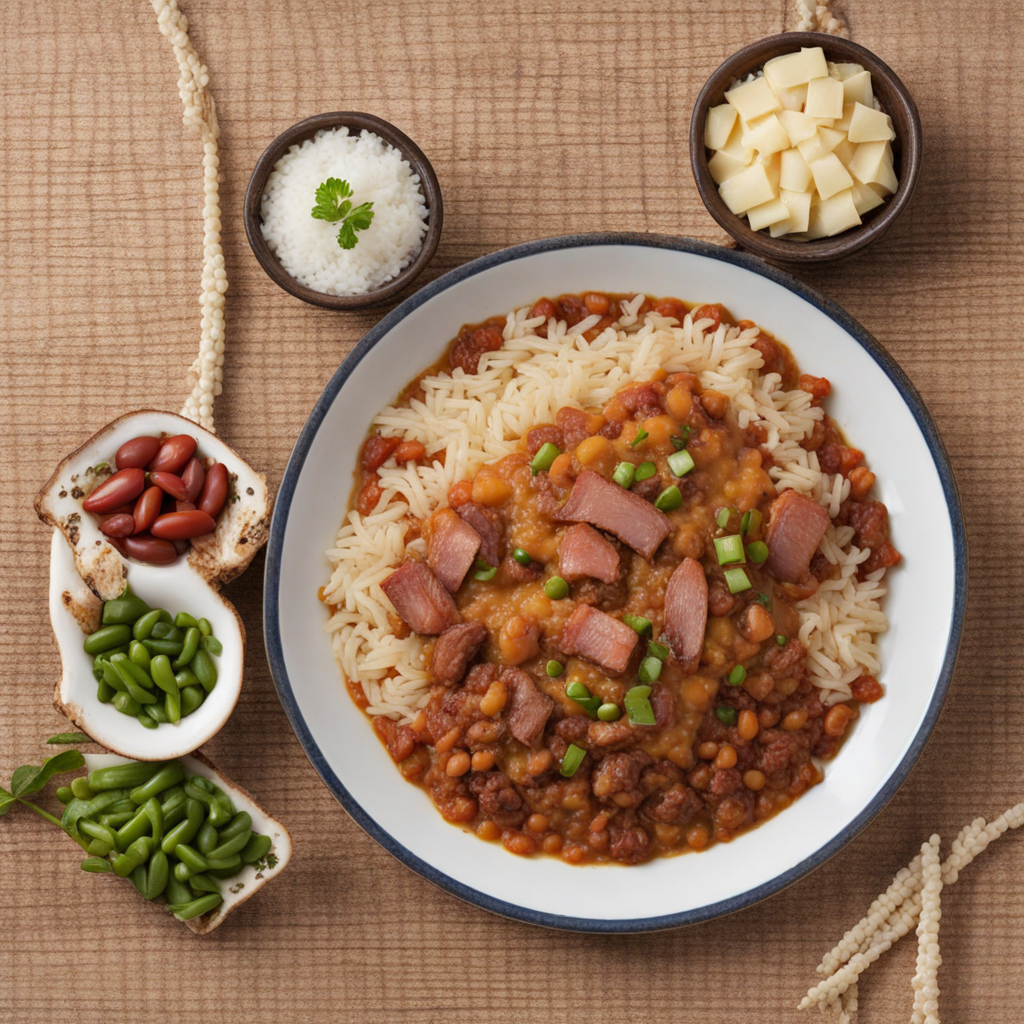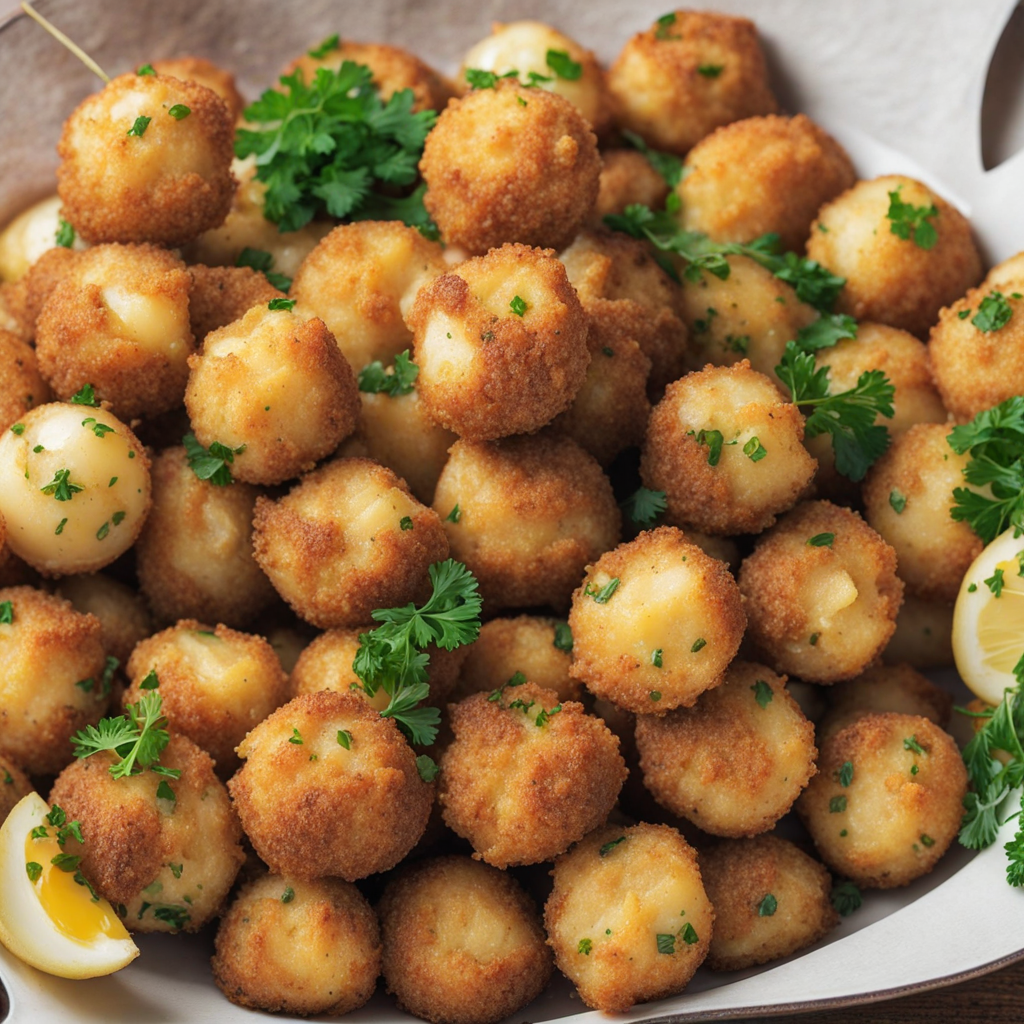Baião de Dois
Baião de Dois is a traditional Brazilian dish that beautifully captures the essence of Northeastern cuisine. At its core, this hearty meal combines two staples—rice and beans—cooked together with a medley of ingredients that reflect the region's rich agricultural heritage. Typically, the recipe features a base of white rice paired with black-eyed peas or cowpeas, which lend a creamy texture and earthy flavor to the dish. The rice and beans are often infused with savory seasonings such as garlic, onion, and cilantro, creating a symphony of taste that is both comforting and satisfying. What sets Baião de Dois apart is its delightful array of additional ingredients. It may include coarsely chopped greens like collard greens or kale, which add a pop of color and a nutritious boost. Additionally, chunks of smoked sausage, such as linguiça or chorizo, are often stirred in, imparting a smoky richness that elevates the dish. Some variations even incorporate cheese, adding a creamy element that melds beautifully with the other flavors. Each bite offers a unique blend of textures and tastes, making it a true feast for the senses. Served warm, Baião de Dois is typically accompanied by a side of farofa—a toasted manioc flour mixture that provides a crunchy contrast. It can be enjoyed as a main course or as a side dish, often found at gatherings and festive occasions throughout Brazil. Whether enjoyed at a bustling street market or in a cozy home setting, Baião de Dois is a celebration of Brazilian culture and a must-try for anyone eager to explore the diverse and vibrant world of South American cuisine.
How It Became This Dish
Baião de Dois: A Culinary Journey Through Brazil's Heartland Baião de Dois is a beloved dish that encapsulates the essence of Brazilian cuisine, particularly reflecting the rich cultural tapestry of the Northeast region. Comprising rice and beans, often accompanied by a medley of spices, meats, and other ingredients, Baião de Dois is more than just a meal; it is a symbol of community, resilience, and the deep-rooted traditions of Brazilian society. Origins The origins of Baião de Dois can be traced back to the indigenous peoples of Brazil, who were among the first to cultivate and consume rice and beans. These two staples, brought together through the influence of African, Portuguese, and indigenous culinary practices, showcase the blending of cultures that defines Brazil’s gastronomic identity. The dish is thought to have emerged in the sertão, the arid hinterlands of the Northeast, where sustenance was often derived from what the land could provide. The name “Baião de Dois” is believed to have originated from the word “baião,” which refers to a traditional dance from the Northeast region, indicating the dish's connection to local customs and festivities. The phrase “de dois” translates to “of two,” representing the two key ingredients: rice and beans. Cultural Significance Baião de Dois is more than just food; it serves as a cultural touchstone for many Northeastern Brazilians. The dish is often prepared during family gatherings, festivals, and communal celebrations, reinforcing the values of togetherness and hospitality. It is typically served with sides such as queijo coalho (a type of cheese), carne de sol (sun-dried beef), or even a fried egg, transforming a simple meal into a feast. The significance of Baião de Dois is also highlighted in Brazilian literature and music. It has been referenced in various works that celebrate the rural lifestyle and the struggles of the sertanejo (people from the sertão). The dish evokes nostalgia and pride, often reminding people of their roots and the agricultural traditions that have sustained generations. Development Over Time The evolution of Baião de Dois can be marked by the influences of various waves of migration and cultural exchange throughout Brazil's history. During the colonial period, Portuguese settlers introduced new ingredients, such as spices and cooking techniques, which were adapted by the local populations. The African influence, brought by enslaved individuals, further enriched the dish with flavors and methods that emphasized the use of slow cooking and communal dining practices. In the 20th century, Baião de Dois gained prominence beyond the Northeast, spreading to urban centers in Brazil, where it became synonymous with comfort food. The dish’s adaptability allowed it to incorporate local ingredients from different regions, leading to variations such as Baião de Dois with shrimp in coastal areas or vegetarian versions in cities with diverse populations. In the 1960s and 1970s, as Brazil underwent significant social and political changes, Baião de Dois took on new meanings. The dish was often associated with the Movimento Armorial, a cultural movement that sought to elevate and celebrate Northeastern folklore and culture through art, music, and literature. Artists and musicians began to highlight Baião de Dois in their works, reinforcing its status as a symbol of regional pride and cultural identity. Modern Interpretations Today, Baião de Dois continues to evolve, reflecting contemporary culinary trends while maintaining its traditional roots. Chefs across Brazil have begun to experiment with the dish, incorporating elements from international cuisines and modern cooking techniques. For example, some gourmet interpretations may feature exotic spices, gourmet cheeses, or artisanal beans, while still honoring the original flavor profile. In recent years, the rise of food tourism in Brazil has also played a role in popularizing Baião de Dois. Travelers seeking authentic culinary experiences are drawn to the dish, often learning about its preparation from local cooks during culinary tours. This resurgence of interest has led to a renewed appreciation for traditional recipes and the stories that accompany them. Conclusion Baião de Dois is a dish that embodies the spirit of Brazil; it is a harmonious blend of diverse influences, reflecting the country’s complex history and cultural richness. From its humble origins in the sertão to its status as a symbol of communal identity, Baião de Dois has transcended its role as mere sustenance to become a cherished part of Brazil's heritage. As it continues to evolve and inspire, Baião de Dois stands as a testament to the resilience and creativity of the Brazilian people. Whether enjoyed in a bustling urban restaurant or a rustic countryside home, it remains a dish that brings people together, celebrating the flavors and traditions of a vibrant nation. In this way, Baião de Dois is not just food; it is a story of connection, history, and love for the land that nurtures it.
You may like
Discover local flavors from Brazil







